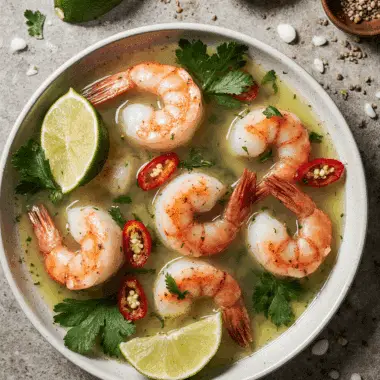Pozole is a cherished traditional Mexican stew made with hominy and typically enjoyed during celebrations like Mexican Independence Day. This vegan version of Pozole captures the heart of the dish while skipping the meat, offering robust flavors, nourishing ingredients, and cultural authenticity.
FULL RECIPE
Ingredients
1.For Both Verde and Rojo Base:
- 2 tablespoons vegetable oil
- 1 medium white onion, chopped
- 3 garlic cloves, minced
- 1 teaspoon ground cumin
- 1 teaspoon dried oregano
- Salt and black pepper to taste
- 6 cups vegetable broth
- 2 (15-ounce) cans white hominy, drained and rinsed
- 1 (15-ounce) can pinto beans or chickpeas (optional, for added protein)
2.Verde Version Specific:
- 1 pound tomatillos, husked and halved
- 2 poblano peppers, deseeded
- 1 jalapeño or serrano pepper (adjust to taste)
- 1 cup fresh cilantro leaves
- ½ cup fresh spinach (for color, optional)
- Juice of 1 lime
3.Rojo Version Specific:
- 3 dried guajillo chiles, stemmed and seeded
- 2 dried ancho chiles, stemmed and seeded
- 2 Roma tomatoes, halved
- ½ teaspoon smoked paprika
- 1 teaspoon chili powder
4.For Garnish (Traditional Toppings):
- Shredded lettuce or cabbage
- Sliced radishes
- Diced avocado
- Fresh cilantro
- Lime wedges
- Dried oregano
- Crushed tortilla chips or tostadas
Directions
- Prepare the Sauce Base:
- For Verde: In a saucepan, boil tomatillos, poblano, and jalapeño for 5–6 minutes until soft. Blend with cilantro, spinach, and lime juice until smooth.
- For Rojo: Toast the dried chiles in a dry pan for 30 seconds per side. Soak in hot water for 10 minutes. Blend with tomatoes, paprika, and chili powder until smooth.
- Cook the Base:
- In a large pot, heat the oil over medium heat. Add chopped onion and cook until translucent (5 minutes). Add garlic, cumin, oregano, and sauté for another minute.
- Add Sauce and Simmer:
- Pour your blended Verde or Rojo sauce into the pot. Cook for 5 minutes to develop flavor.
- Build the Soup:
- Stir in vegetable broth and bring to a simmer. Add hominy and optional beans. Season with salt and pepper. Cover and simmer for 20–25 minutes to marry flavors.
- Taste and Adjust:
- Add more salt, lime juice (for Verde), or a pinch of sugar (for Rojo) if needed. Simmer uncovered for an additional 5 minutes if a thicker texture is desired.
- Serve and Garnish:
- Ladle pozole into bowls and top generously with garnishes like shredded lettuce, radishes, avocado, and lime.
Nutrition Facts
- Calories: 260
- Total Fat: 7g
- Saturated Fat: 1g
- Sodium: 640mg
- Total Carbohydrates: 38g
- Dietary Fiber: 8g
- Sugars: 4g
- Protein: 8g
- Vitamin A: 20% DV
- Vitamin C: 35% DV
- Iron: 15% DV
- Calcium: 6% DV
Cultural Significance of Pozole in Mexican Cuisine
Pozole holds a deeply rooted place in Mexican culinary tradition, dating back to pre-Columbian times when it was considered sacred. Historically made with maize and served during ritual celebrations, it later evolved to reflect regional and cultural identities. Today, it’s a signature dish for major festivities like Mexican Independence Day and Christmas. Both Pozole Verde and Pozole Rojo represent regional styles—Verde originating from the central and southern areas like Guerrero, while Rojo is more common in northern and central Mexico. Making a vegan version honors the heritage while adapting the recipe to contemporary, inclusive diets.
Health Benefits of a Vegan Pozole
Vegan Pozole provides a hearty, balanced, and nutritious meal without relying on animal-based ingredients. Hominy, the core ingredient, is rich in fiber and essential minerals like magnesium and phosphorus. The broth and vegetables contribute antioxidants and phytochemicals that support immune function and reduce inflammation. By avoiding meat, this version also reduces saturated fat and cholesterol intake, supporting heart health. Adding beans increases the protein content and makes the stew more satiating. With its blend of vegetables, herbs, and whole foods, vegan pozole aligns with plant-forward dietary recommendations.
Pozole Verde vs. Pozole Rojo
While both dishes are built on a base of hominy and broth, the flavor profiles differ significantly between Pozole Verde and Pozole Rojo. Verde uses green ingredients such as tomatillos, poblano peppers, and cilantro to create a zesty, herbaceous taste with mild heat and freshness. Rojo, on the other hand, features dried red chilies like guajillo and ancho for a smoky, earthy flavor with deeper spice notes. Each version offers a unique culinary experience, and choosing between them often depends on personal preference or regional tradition. Both are equally valid expressions of the same foundational dish.
Popular Garnishes and How They Enhance Flavor
Toppings are essential to pozole and bring layers of texture, flavor, and visual appeal. Traditional garnishes include shredded cabbage or lettuce for crunch, sliced radishes for peppery brightness, and avocado for creaminess. Fresh lime juice adds acidity that balances the richness of the stew, while oregano and chili flakes offer depth and spice. Crushed tortilla chips or tostadas provide a welcome contrast to the tender hominy. The garnishes are more than just decorative—they’re an interactive part of the meal, allowing diners to customize each bowl to their liking.
Serving Suggestions for Special Occasions
Pozole is best served piping hot in large bowls, making it perfect for festive gatherings, family dinners, or community celebrations. It’s traditionally enjoyed as a main dish, often accompanied by side items such as Mexican rice, tamales, or freshly baked bolillos (Mexican bread rolls). For a more casual setting, it pairs well with corn chips or quesadillas. The customizable nature of pozole makes it ideal for serving a group with varying tastes. Each person can add their favorite toppings, making it an engaging and communal dining experience.
Ideal Beverage Pairings
This rich and spicy stew pairs well with a variety of traditional and modern drinks. For an authentic experience, consider serving it with aguas frescas such as tamarind, hibiscus (jamaica), or horchata. These lightly sweetened beverages counterbalance the heat and tang of the pozole. For adult gatherings, Mexican beer like a light lager or a smoky mezcal-based cocktail complements the dish’s bold flavors. Sparkling water with lime is also a refreshing non-alcoholic pairing that helps cleanse the palate between bites.
How to Store and Reheat Leftovers
Pozole stores exceptionally well and often tastes even better the next day as the flavors meld further. To store, allow the stew to cool completely, then transfer it to airtight containers. It can be refrigerated for up to five days or frozen for up to three months. When reheating, use a stovetop over medium heat, stirring occasionally until hot. If the soup has thickened, add a bit of vegetable broth or water to restore its original consistency. Avoid reheating garnishes—add fresh toppings after warming for the best results.
Creative Recipe Variations to Try
There are numerous ways to tweak vegan pozole to match different dietary needs or flavor profiles. For a protein boost, add tofu, tempeh, or jackfruit as meat substitutes. Swap pinto beans with black beans or lentils for a variation in texture. You can also experiment with seasonal vegetables like zucchini, mushrooms, or chayote for added nutrition and color. Spice lovers may enjoy adding chipotle peppers for a smoky heat, while others might reduce the number of chilies to make the dish more kid-friendly. Pozole is adaptable and welcomes creative interpretation.
Sourcing Authentic Ingredients
Finding quality ingredients is key to making a flavorful pozole. Hominy can be found canned or dried in Latin American grocery stores or international aisles of supermarkets. Dried chilies like guajillo, ancho, and pasilla offer the best depth of flavor, and should be pliable and aromatic. Fresh tomatillos, cilantro, and poblanos are essential for the Verde version and may require a visit to a specialty store or local farmers market. When possible, opt for organic produce and non-GMO hominy for the most wholesome result.
Why Pozole is Perfect for a Vegan Transition
For those transitioning to a vegan lifestyle or incorporating more plant-based meals, pozole offers a comforting yet exciting introduction. Its bold flavors and satisfying textures rival any meat-based stew, proving that vegan food can be just as hearty and delicious. It respects tradition while embracing modern dietary preferences, showing that plant-based cooking doesn’t require sacrifice. Moreover, its flexibility, cultural richness, and ability to nourish both body and spirit make it a staple worth adding to any vegan recipe rotation.
Conclusion
Vegan Pozole, whether Verde or Rojo, is more than just a plant-based stew it’s a celebration of heritage, nourishment, and culinary creativity. With its bold flavors, rich textures, and interactive garnishes, it offers a complete meal that’s ideal for holidays or everyday comfort. Adaptable to personal tastes and dietary needs, this dish continues to bring people together around the table, just as it has for generations.







